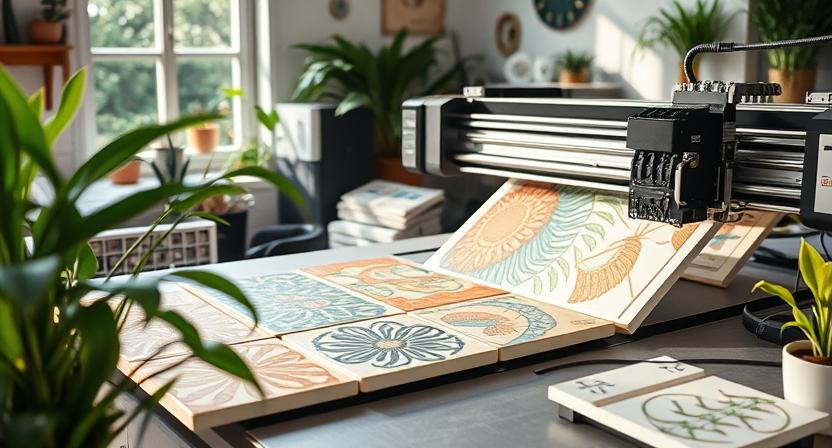As awareness of environmental issues grows, industries are increasingly adopting sustainable practices, and the ceramic printing sector is no exception. Ceramic printing offers an eco-friendly alternative to traditional decoration methods, combining artistry with sustainability. This makes it a favored choice for environmentally conscious consumers and businesses looking to reduce their carbon footprint without compromising on style and quality.
Ceramic printing is a technique that applies designs onto ceramic surfaces through digital or screen printing, followed by firing to make the print permanent. This process is efficient, minimizes waste, and uses materials that often have lower environmental impact compared to conventional methods. Additionally, ceramic products themselves are long-lasting and recyclable, further enhancing their sustainability profile.
How Ceramic Printing Reduces Waste?
One of the key environmental benefits of ceramic printing is its precision. Unlike manual painting or stencil methods that may generate excess ink or materials, digital ceramic printing deposits the exact amount of ink needed for the design. This controlled application reduces waste significantly.
Moreover, the printing process avoids the need for physical screens or plates that are typical in older printing methods, cutting down on the materials required for production. The firing process bonds the design to the ceramic, eliminating the need for additional protective coatings that may contain harmful chemicals.
Energy Efficiency in Ceramic Printing
Modern ceramic printing facilities often employ energy-efficient kilns and equipment. Innovations such as faster firing cycles and better insulation help reduce the energy consumption during the high-temperature firing phase. Since firing is essential for making the print durable and resistant, these efficiencies have a direct positive impact on the overall environmental footprint.
Some manufacturers also integrate renewable energy sources into their operations, such as solar or wind power, to further lessen reliance on fossil fuels.
Use of Eco-Friendly Inks and Materials
The inks used in ceramic printing have evolved to meet environmental standards. Many manufacturers now use low-VOC (volatile organic compounds) inks, which emit fewer harmful chemicals into the air. These inks also provide vibrant colors and excellent adhesion without compromising on health or environmental safety.
In addition to inks, ceramic substrates can be sourced from recycled materials or from manufacturers who practice sustainable mining and production methods. This holistic approach to materials enhances the eco-friendly nature of ceramic printing.
Longevity and Durability Contribute to Sustainability
Sustainability in ceramics is not only about production but also about the lifespan of the products. Ceramic printing results in designs that are permanently fused to the surface, making them resistant to scratching, fading, and wear. This durability means that ceramic products last longer and require fewer replacements, reducing waste over time.
Tiles, dinnerware, and decorative pieces that retain their appearance for years contribute to less frequent consumption and disposal, which is crucial for environmental preservation.
Recycling and End-of-Life Considerations
Ceramics are inherently recyclable and inert, meaning they do not release toxins when disposed of properly. Many ceramic products can be crushed and reused as aggregate in construction or landscaping, closing the loop in their lifecycle.
The permanence of ceramic printing designs means products can be repurposed or refurbished without loss of aesthetic value, further extending their useful life and minimizing waste.
Ceramic Printing Compared to Other Decorative Techniques
Compared to vinyl decals, hand painting, or plastic-based coatings, ceramic printing offers a cleaner and more durable alternative. Vinyl and plastic decorations often involve synthetic materials that are difficult to recycle and may release microplastics into the environment. Hand painting, while artisanal, can be less efficient and produce more waste.
Ceramic printing strikes a balance by combining high-quality decoration with sustainable production practices, appealing to a broad market segment focused on eco-conscious choices.
The Role of Ceramic Printing in Green Building and Design
Green building standards increasingly encourage the use of sustainable materials and practices. Ceramic printing aligns with this trend by offering customized, durable ceramic products that meet aesthetic and environmental goals.
Interior designers and architects use printed ceramic tiles and panels to create eco-friendly spaces that do not compromise on beauty or functionality. The ability to customize designs also reduces the need for excess inventory and allows precise ordering, minimizing overproduction.
Future Developments for Sustainability in Ceramic Printing
Ongoing research is focused on further reducing the environmental impact of ceramic printing. This includes developing new inks that require lower firing temperatures, innovations in kiln technology, and improvements in waste recycling during production.
Collaborations between manufacturers, designers, and environmental organizations aim to establish industry standards that promote sustainability without sacrificing quality.
Conclusion
Ceramic printing represents a sustainable choice for modern decor by minimizing waste, using eco-friendly materials, and producing long-lasting products. Its combination of environmental responsibility and design versatility makes it an attractive option for consumers and businesses alike. As technology advances, ceramic printing will continue to enhance its eco-friendly credentials, supporting the global movement toward greener, more sustainable living and design.





Comments